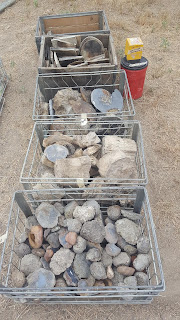I worked my way along the stream. Reaching a large shallow pool,
I cast my fly and hoped that a cutthroat was hiding under the bank. As it
drifted downstream five trout suddenly appeared, four small ones and one of the
largest cuts I had seen in quite a while.
My first thought was that they had been spooked by my presence,
but the small trout took refuge in the undercut bank and the large trout turned
upstream and engulfed my fly, (a purple haze colored Adams). Setting the hook,
I fought the fish and for a while it was a standoff.
I knew that the five-x leader should hold but only if I took
my time to tire the fish. Of course, I remembered that I had caught and
released fifteen others that day and had not retied the fly. Slowly the fish
tired and I was able to guide the fish to a narrow inlet, where leaving the
fish in the water, I was able to measure the fish and release it safely. The
fish darted back to its home. It was a nineteen-inch fish, a Bonneville cut and
the largest cut I had caught in years.
(The above picture is of Heart Mountain, which was one of the sites where Japanese Americans were interned during World War Two. The haze is from a forest fire.)
Two days later and we were driving to Cody, Wyoming. This
time the trip wasn’t about fishing but all about fossils! While at the Cody
show several collectors had approached us and told us of their collections. One
had said that he was selling much of his grandfather’s collection.
Years ago, his grandfather had owned a rock shop in
Greybull, where he sold his personal finds and fossils he had traded for from
England and Germany. Included n the items for sale were thunder eggs, petrified
wood, and thousands of ammonites.
Of course, I couldn’t wait to see them, and so we drove the
three hundred and fifty miles hoping the trip would be worthwhile. Spending the
night in Thermopolis,Wyoming we rose early and made the trip to Cody. Meeting
the grandson and his wife we looked over the fossils and while enjoying the vast
collection we were treated to many beautiful specimens that the couple were
keeping.
One was a thunder egg half that contained the largest fire
opal I had ever personally seen. It was the best red color, had no flaws and I
told them my estimated value of the stunning precious gemstone. It was not for
sale and so it was okay to give them an estimate of its value, (It is unethical
to appraise a piece and then offer to buy it and is illegal to do so in many
states). As a result, we no longer appraise items unless they are not for sale.
So now it was time for the dance. Normally you let the owner
set a price and then offer them less. If you take the sellers first price,
without dickering, they often think that they have undervalued the collection.
I told them they had underpriced the collection, (and they knew it), and
offered them more than the stated price.
They looked at each other and agreed to my offer! So now we
have several thousand ammonites, some from around the world, but most from
Wyoming, Montana, and South Dakota. Now comes the hardest part, identifying the
genus and species and then determining the price.
Quite a few are large and are display specimens and so we
need to figure out display stands. Some will be formed into our jewelry, but
most will be sold as is. One can never have enough rocks and fossils and
someday Matt and Jenny will look at the collection and say to each other, “What
are we going to do with all of these?” Lol, and of course Clear skies







WOW!! Great catching and great rocks all in one post.
ReplyDelete